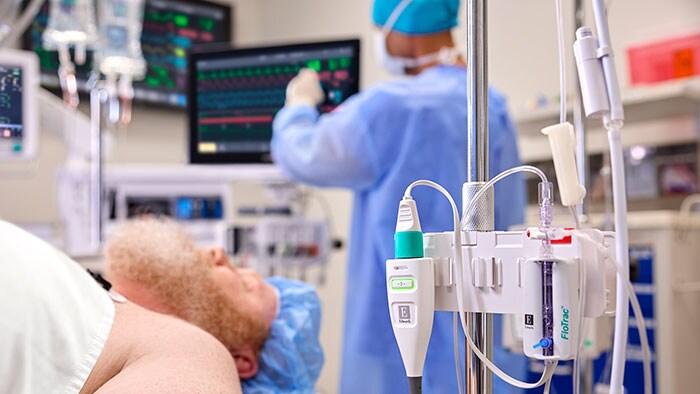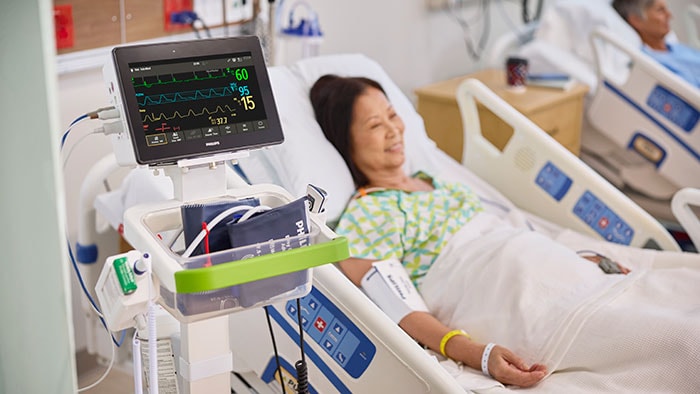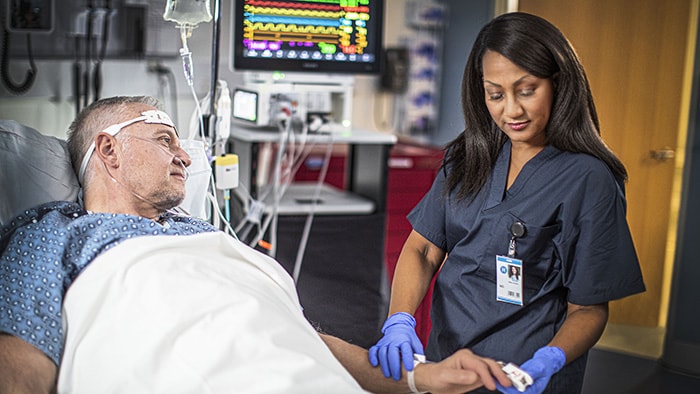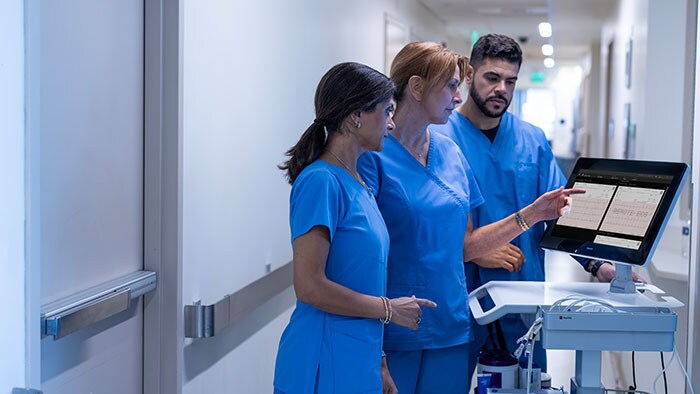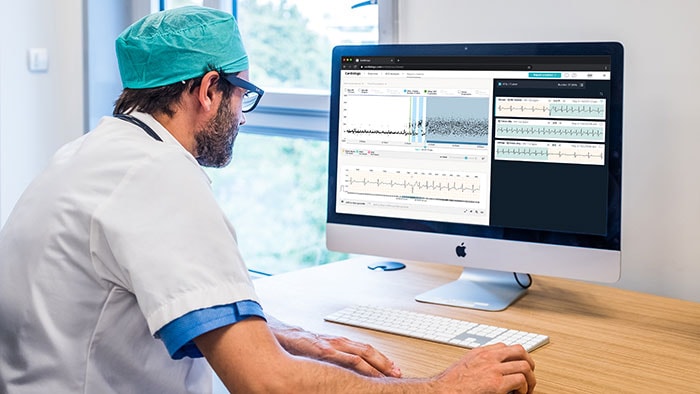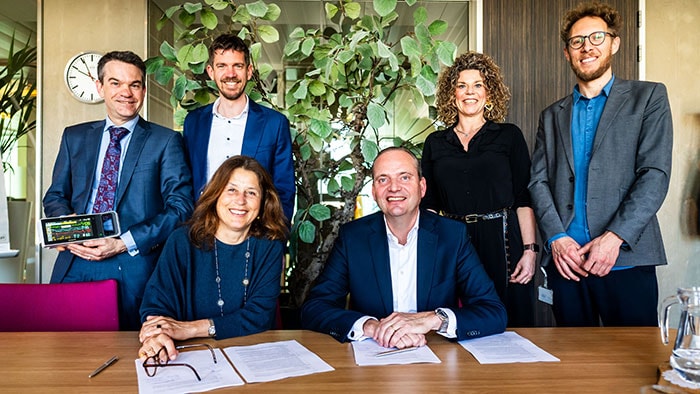Van data naar inzichten; hoe Philips de operatiekamer veiliger wil maken met een avatar
feb 05, 2025 | 3 minuten leestijd
Een operatiekamer is een complexe en hectische omgeving. Beslissingen moeten vaak in seconden worden genomen, maar het analyseren van grote hoeveelheden data kan tijdrovend zijn. Philips biedt een oplossing: de Visual Patient Avatar. Deze innovatie vertaalt patiëntdata naar een intuïtieve en visuele weergave. Clinici zien in één oogopslag wat er speelt, waardoor ze sneller en nauwkeuriger kunnen handelen. “Het is de grootste verandering in monitoring in operatiekamers,” zegt Axel van Boxtel, Business Development Manager bij Philips.
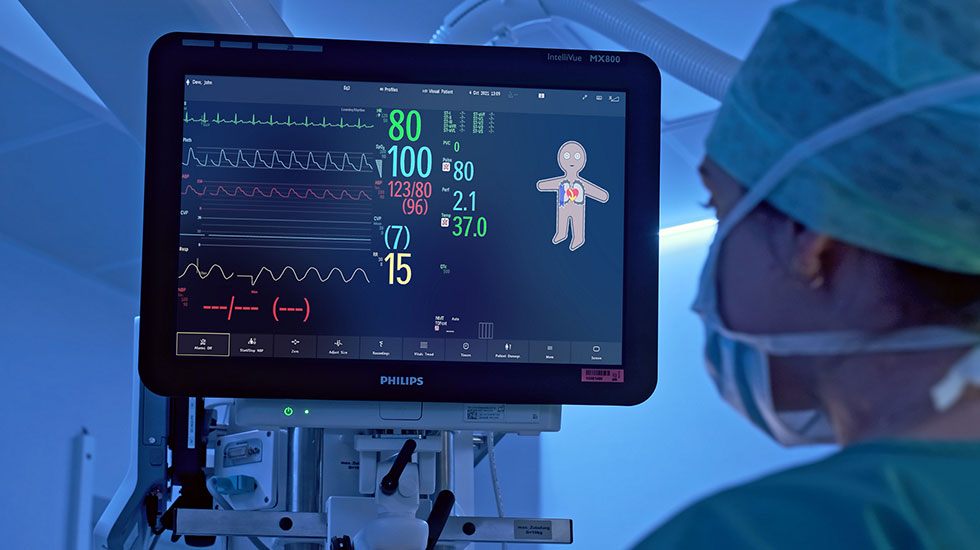
Axel sprak afgelopen week tijdens het ICT & Health World Conference in het MECC in Maastricht voor een volle zaal over een van zijn favoriete onderwerpen: hoe je data kunt visualiseren om betere beslissingen te kunnen maken. “Het is ‘slechts’ een poppetje op het scherm, maar uiteindelijk beseft zelfs de grootste criticus dat het zeer waardevol kan zijn in een hectische omgeving”, zegt hij over de avatar. “We helpen clinici om meerdere signalen tegelijk te interpreteren en maken subtiele veranderingen in status inzichtelijk. We sturen de aandacht van clinici naar wat écht belangrijk is, zodat ze betere beslissingen kunnen nemen voor betere zorg.”
Inspiratie uit de luchtvaart
De avatar is een mooi voorbeeld van hoe twee verschillende sectoren bij elkaar kunnen komen. Deze innovatie in de operatiekamers is namelijk geïnspireerd door luchtvaarttechnologie en ondersteunend onderzoek. Waar piloten vroeger schermen vol knoppen en cijfers moesten interpreteren, gebruiken ze nu een visuele weergave van het vliegtuig, de omgeving en belangrijke parameters zoals hoogte en snelheid. Deze zogenoemde ‘synthetic vision’ maakt het voor piloten eenvoudiger om cruciale informatie snel te begrijpen en de juiste beslissingen te nemen.
Meer data is niet altijd beter
Datzelfde principe wordt nu gebruikt om zorgprofessionals te ondersteunen in hun werkzaamheden in het ziekenhuis. De hoeveelheid medische data in het ziekenhuis is de laatste jaren enorm toegenomen door een stijgend aantal metingen. Dit maakt het voor zorgprofessionals steeds moeilijker om op tijd de juiste informatie te verwerken en een beslissing te maken. “Dat vergroot de kans dat ze wat missen, omdat ze misschien niet de juiste informatie op het juiste moment zijn”, zegt Axel. “En dat kan direct een nadelig gevolg hebben voor de patiënt.”
Visualisatie is cruciaal
Artsen moeten focussen op hun patiënten, maar hebben tegelijkertijd bewustzijn van de situatie (situation awareness) nodig om de signalen uit de omgeving op te pikken. Ze kunnen bijvoorbeeld hun aandacht net op wat anders hebben gevestigd, waardoor ze een belangrijk detail missen en daardoor een verkeerde beslissing nemen. Uit onderzoek blijkt dat maar liefst 88% van de ongelukken in de luchtvaart te maken heeft met een gebrek aan situation awareness [1]. In de gezondheidszorg speelt dit probleem ook een grote rol: 80% van de incidenten bij anesthesie wordt veroorzaakt door een gebrek aan overzicht of interpretatiefouten [2].
Complexiteit verminderen
De Visual Patient Avatar geeft artsen de tools om al deze informatie snel en efficiënt te begrijpen. Door gegevens uit de Philips IntelliVue patiëntmonitoren om te zetten in een visueel model, wordt complexe data eenvoudiger te interpreteren. Axel: “Waar je bijvoorbeeld eerst tijd nodig had om de status van een patiënt te evalueren door verschillende datapunten met elkaar te combineren, kun je dat met de avatar nu in bijvoorbeeld in enkele seconden.”
Impact in de zorg
De avatar wordt in Europa nu steeds verder uitgerold in ziekenhuizen. Axel verwacht uiteindelijk dat ieder ziekenhuis kan profiteren van de voordelen van deze innovatie. “Er komt alleen maar meer informatie bij en dus stijgt de noodzaak om clinici te helpen deze data te interpreteren, zodat zij betere zorg kunnen leveren. De avatar is daar een intuïtieve oplossing voor. We verbeteren hiermee de workflow én verhogen de patiëntveiligheid.”
Bronnen [1] Endsley. Hum Factors.1988, CRC Press. 2011.
[2] Schulz et al. BMCA. 2016, Anesthesiology. 2017.
From data to insights: How Philips aims to make the operating room safer with an avatar
An operating room is a complex and hectic environment. Decisions often need to be made in seconds, but analyzing large amounts of data can be time-consuming. Philips offers a solution: the Visual Patient Avatar. This innovation translates patient data into an intuitive and visual representation. Clinicians can see at a glance what is happening, enabling them to act faster and more accurately. “It’s the biggest change in operating room monitoring,” says Axel van Boxtel, Business Development Manager at Philips.

Axel spoke last week at the ICT & Health World Conference at the MECC in Maastricht in front of a packed audience about one of his favorite topics: how data visualization can support better decision-making. “It’s ‘just’ a small figure on the screen, but even the biggest skeptic eventually realizes how valuable it can be in a high-pressure environment,” he says about the avatar. “We help clinicians interpret multiple signals simultaneously and make subtle changes in patient status more transparent. We direct their attention to what truly matters so they can make better decisions for better care.”
Inspiration from aviation
The avatar is a great example of how two different industries can come together. This operating room innovation was inspired by aviation technology and supporting research. In the past, pilots had to interpret screens filled with buttons and numbers, but now they use a visual representation of the aircraft, its surroundings, and key parameters such as altitude and speed. This so-called ‘synthetic vision’ helps pilots quickly grasp crucial information and make the right decisions.
More data is not always better
This same principle is now being used to support healthcare professionals in hospitals. The amount of medical data in hospitals has significantly increased in recent years due to the growing number of measurements. As a result, it is becoming increasingly difficult for healthcare professionals to process the right information in time and make decisions. “This increases the risk of missing something because they may not have the right information at the right moment,” says Axel. “And that can have immediate negative consequences for the patient.”
Visualization is crucial
Doctors must focus on their patients while also maintaining situational awareness to pick up on signals from their surroundings. They may momentarily focus on something else, missing an important detail and making a wrong decision as a result. Research shows that 88% of aviation accidents are linked to a lack of situational awareness [1]. The same issue plays a major role in healthcare: 80% of anesthesia-related incidents are caused by a lack of oversight or interpretation errors [2].
Reducing complexity
The Visual Patient Avatar provides doctors with the tools to quickly and efficiently understand all this information. By converting data from Philips IntelliVue patient monitors into a visual model, complex data becomes easier to interpret. Axel explains: “Previously, evaluating a patient’s status required time to combine multiple data points. With the avatar, this can now be done in just a few seconds.”
Impact on healthcare
The avatar is now being rolled out in hospitals across Europe. Axel ultimately expects every hospital to benefit from this innovation. Axel: “With the ever-growing amount of information, the need to help clinicians interpret data is increasing. The avatar offers an intuitive solution for this. It improves workflow and enhances patient safety.”
Sources [1] Endsley. Hum Factors.1988, CRC Press. 2011.
[2] Schulz et al. BMCA. 2016, Anesthesiology. 2017.


